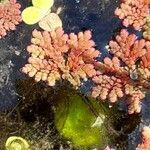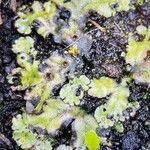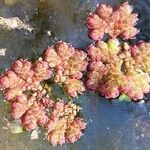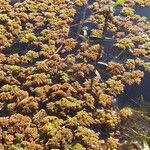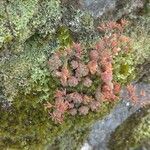Plants green to yellowish green or dark red, with 2 growth stages; plants fertile only in mature stage, generally in late spring. Stems prostrate when immature, 1--3 cm, internodes elongate to 5 mm, becoming nearly erect to 5 cm or more when mature and crowded. Hairs on upper leaf lobes strictly unicellular. Megaspores warty with raised angular bumps, each with a tangle of filaments.
Plants more robust than Azolla imbricata. Lateral branches axillary, numbers of lateral branches less than fronds of stem; when in shallow water or wet places or plants in crowded situations, stems becoming erect and dorsal lobes changing to ventral ones. Sporangium with 3 floats on exospore; massulae of microsporangium covered with anchorlike hairs.
Plants free-floating, forming extensive red-coloured mats, up to 3 × 3 cm, broadly ovate to elliptic in outline or broader than long, irregularly branched, with secondary branchlets decreasing in length only slightly towards the distal end of primary branches. Lvs 2-lobed; upper lobe ovate, 1-2 mm long. Roots to 7 cm long, entire.
Free-floating aquatic plant; branching irregular, not noticeable pinnate. Roots borne singly. Leaves silvery green, with wine-red tinge in winter, broadly ovate to almost circular, up to 1.1 mm long. Megasporocarps with prominent dark apex; megaspores with 3 massulae. Microsporocarps borne singly or subtended by a megasporocarp.
Free-floating, perennial herb with horizontal, minutely papillate rhizome, roots borne singly. Upper leaf lobe ovate, lower lobe hyaline. Megasporocarps with prominent dark apex, microsporocarps borne singly or subtended by a megasporocarp.
Perennial with horizontal, minutely papillate rhizome, roots borne singly. Upper leaf lobe ovate, lower leaf lobe hyaline. Null Megasporocarps with prominent dark apex, microsporocarps borne singly or subtended by a megasporocarp.
Floating aquatic plant. Roots borne singly. Megaspores surmounted by 3 massulae. Massulae of microspores armed all round with rigid glochidia with anchor-shaped tips.
